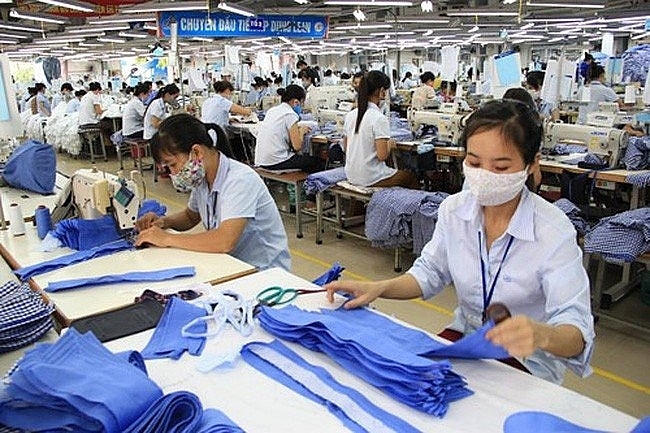
AsemconnectVietnam - Vietnam’s textile and garment industry is facing a tough uphill battle as it is working hard to achieve its ambitious export target of US$39-40 billion for the year, according to the Vietnam Textile and Apparel Association (VITAS).
Recent data from the association showed that textile and garment export revenue in the first half of 2023 amounted to US$18.6 billion, a 17.6% drop compared to the same period in 2022.
Imports into the country plunged a sharp 20.5% year-on-year in the January-June period, resulting in a trade surplus of US$7.9 billion, which is nearly US$1 billion lower than in the same period in 2022.
The sector has been affected by fewer orders from key markets such as the US and the EU, according to Vitas. The global economy has continued to decline, with annual growth being forecast at less than 2 per cent, or lower than the 3 per cent recorded last year.
Exports to the US were down 27.1 per cent in the first five months of the year, to the EU 6.2 per cent, to Canada 10.9 per cent, and to South Korea 2 per cent.
The textile and garment industry targets $39-40 billion from exports this year.
Global textile demand is projected to decrease from US$757 billion to around US$712 billion, and it could potentially reach as low as US$687 billion.
The ongoing global economic slowdown has impacted export figures due to reduced orders from major markets. Textile exports to the U.S. plummeted by 27.1% during the first five months, while exports to Canada and the EU declined by 10.9% and 6.2% respectively.
In addition to these challenges, Vietnamese textile exporters are facing fierce competition from manufacturing powerhouses like China. Diminishing demand from major markets further worsens the situation, making Vietnam one of the first countries to bear the brunt of declining textile orders.
Textile businesses in Vietnam are contending with significant drops in product prices, with some experiencing reductions of over 50% compared to previous years. High lending rates, averaging between 9% and 11%, further increase production costs compared to other export-oriented nations.
Moreover, the average monthly wage for textile workers in Vietnam is around US$300, considerably higher than in other exporting nations like Bangladesh (US$95), Cambodia (US$190), and India (US$145). This wage disparity poses a significant challenge for Vietnam’s textile industry to remain cost-competitive.
China’s active support for its domestic textile industry adds another layer of complexity. The country has taken measures to strengthen production and maintain its position as the leading global textile manufacturer. As China increases its supply, Vietnam faces even fiercer competition in the textile market, exacerbating the challenges it already faces.
There is growing pressure to adopt greener and more sustainable production practices, requiring additional efforts from Vietnamese exporters to secure new orders. This involves developing eco-friendly raw materials, creating reusable and recyclable clothing, and reducing the environmental impact of the production process.
VITAS Vice Chairman and Secretary General Truong Van Cam has emphasized key measures to support Vietnam’s textile and garment industry in achieving its ambitious export target. These measures include retaining skilled personnel, investing in employee upskilling, fostering customer loyalty, and optimizing business expenses.
Solutions to meet EU's EPR schemes
The Vietnam Textile and Apparel Association said that the Commission is proposing to introduce mandatory and harmonized Extended Producer Responsibility (EPR) schemes for textiles.
Accordingly, the Commission is proposing rules to make producers responsible for the full life cycle of textile products and to support the sustainable management of textile waste across the EU.
Chairman of the HCMC Association of Garments, Textiles, Embroidery and Knitting Pham Xuan Hong said that if the EU applied for the EPR program, it would also force textile and garment manufacturing enterprises to have solutions to collect, classify, reuse and recycle textiles and garments for exports to the EU market. This is very difficult, so the association as well as textile enterprises are working with their partners and distribution systems to proactively develop implementation solutions to meet the standards set by the EU market.
Golden time for Vietnamese apparel sector switch to green production
The green transition has been increasingly implemented by businesses in Việt Nam for the past five years. Although the implementation progress is still relatively slow, with the inevitable motivation to improve the industry's advantages, it is the best time for domestic enterprises to focus on accelerating transformation.
Việt Nam's textile and garment industry will continue to face difficulties in the coming months due to the decreasing orders from markets like the US and EU, according to Việt Nam Textile and Apparel Association (VITAS).
Statistics from VITAS showed that in the first half of the year, the industry’s export turnover was estimated at US$18.6 billion, down 17.6 per cent over the same period last year. Meanwhile, the import turnover also reduced by 20.5 per cent to $10.7 billion in the first six months of the year.
VITAS forecasts that production and export of textiles and garments will gradually improve, but difficulties will continue until the end of 2023 as many businesses have not yet had enough orders for the third and fourth quarters.
As such, the garment and textile sector set an export turnover target of $40 billion this year.
Compiled by T.Huong
Source: Vitic






